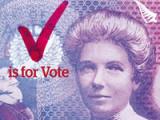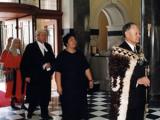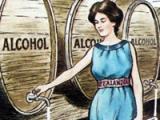New Zealand rugby sevens team turned the tables on 2016 Olympic champions Australia, winning a thrilling final at Robina Stadium on the Gold Coast in extra time.
Suffrage 125
Events In History
In the 2010s New Zealand’s women’s hockey team was consistently among the best in the world, but until 2018 it had not won a major tournament
Alexia Pickering’s induction into the Attitude Awards Hall of Fame recognised her lifelong dedication to championing accessibility for all New Zealanders.
Following the success of her single ‘Royals’, Lorde’s first studio album Pure heroine debuted at number three on the US Billboard 200 charts
Valerie Adams won gold in the shot put at the London Olympic Games. It was awarded a week after the competition, when the intial winner was disqualified for testing positive for an anabolic steroid.
Just how close the New Zealand and Australian netball teams were became clear as the match, the longest official game of netball ever played, stretched over 84 pulsating minutes.
At the 2008 Beijing Paralympics, 15-year-old Sophie Pascoe won her first medal, a silver in the women's 100m butterfly S10. She went on to win gold medals in 100m backstroke S10, 100m breaststroke SB9 and 200m individual medley SM10.
Twenty-nine-year-old Moana Mackey entered the House of Representatives as a Labour Party list MP. She joined her mother, Janet Mackey, who had been a Labour MP since 1993. They were the first mother and daughter to serve together in New Zealand’s Parliament.
The Prostitution Reform Act was passed on a tumultuous night in Parliament, with the public galleries filled with supporters from both sides.
The swearing-in of Dame Silvia Cartwright as New Zealand’s 18th governor-general completed a female clean sweep of the country’s most powerful political and legal positions.
Georgina Beyer won the Wairarapa electorate for Labour in 1999 by a margin of 3033 votes.
On 8 August 1995 Farida Sultana and seven other women met to discuss the establishment of a culturally specialist support service for Asian, Middle Eastern and African women in New Zealand.
At the age of 37, Lorraine Moller ran the race of her life to place third in the marathon at the Barcelona Olympics.
Based on the autobiographies of Janet Frame, An angel at my table was screened in 35 countries and won multiple awards, including a Grand Special Jury prize in Venice.
Dr Penny Jamieson’s rise through church ranks was rapid. The first women were ordained to the Anglican priesthood in New Zealand in 1977. Jamieson was ordained and appointed to a Wellington parish in 1985.
Air New Zealand was found to be in breach of the Human Rights Act after more than a decade of female cabin crew campaigning for the same opportunities as male workers at the airline.
The report was triggered by the publication in Metro magazine of ‘An Unfortunate Experiment’, an article by Sandra Coney and Phillida Bunkle which alleged that cervical cancer patients at Auckland’s National Women’s Hospital were receiving inadequate treatment.
Ann Hercus became New Zealand’s first Minister of Women’s Affairs following the election of the fourth Labour government.
In 1984, Susan Devoy became the first New Zealander to win the women’s title at the prestigious British Open squash tournament, the ‘Wimbledon of Squash’.
Lorraine Downes became a household name overnight and spent the next 12 months travelling the world accompanied by a chaperone, carrying out the duties of Miss Universe
For six minutes New Zealand opera star Kiri Te Kanawa took centre stage at the highly anticipated wedding of Prince Charles to Lady Diana Spencer at St Paul’s Cathedral, London
Tinsley became the first woman to be appointed as Professor of Astronomy at Yale University in the United States
The Act specified the circumstances in which contraceptives could be supplied to young people, sterilisations could be undertaken, and abortions could be authorised.
About 5000 marchers arrived at Parliament and presented a petition signed by 60,000 people to Prime Minister Bill Rowling. The primary aim of the hīkoi (march) was to protest against the continuing loss of Māori land.
The passage of the Social Security Amendment Act introduced the domestic purposes benefit (DPB) to New Zealand’s social welfare system.
Whetu Tirikātene-Sullivan became the first female Māori Cabinet minister when she was sworn in as Minister of Tourism in Norman Kirk’s third Labour government
New Zealand’s women cricketers achieved their first test victory at the 17th attempt. They had lost seven and drawn nine of their previous tests, all against either England or Australia.
New Zealand’s first family planning clinic opened above a garage in Remuera, Auckland.
Eighty-seven delegates attended the first day of the inaugural conference of the Māori Women’s Welfare League in Wellington. Dame Whina Cooper was appointed as president.
Iriaka Rātana was elected as New Zealand’s first female Māori MP.
When mabel Howard was appointed minister of health and minister in charge of child welfare, she became the first woman to serve as a Cabinet minister in New Zealand.
The Women Jurors Act provided for women aged between 25 and 60 to have their names placed on the jury list on the same basis as men – if they so desired.
Calls for policewomen had been made since the 1930s, when the National Council of Women started lobbying for women officers.
The Women’s Auxiliary Air Force (WAAF) was formed to enable the Royal New Zealand Air Force to release more men for service overseas during the Second World War.
The Labour Party’s Elizabeth McCombs became New Zealand’s first female Member of Parliament, winning a by-election in the Lyttelton seat caused by the death of her husband, James McCombs.
The first issue of the New Zealand Woman’s Weekly was distributed during the Depression. The magazine contained advice on cooking and housework, romantic short stories, knitting patterns and feature articles.
In a world first, 30 women began training as dental nurses for the state-funded School Dental Service.
Violet Waldron was New Zealand’s first female Olympian, and part of New Zealand’s first Olympic team of four. She competed in freestyle swimming in the 1920 Antwerp Summer Olympics.
The passing of the Women’s Parliamentary Rights Act enabled women to stand for election to the House of Representatives, 26 years after they won the right to vote.
Freda du Faur was the first female to complete the ascent of Aoraki/Mt Cook.
At a meeting in Wellington, Marianne Tasker and supporters established a domestic workers’ union, hoping to use the Liberal government’s Industrial Conciliation and Arbitration Act to force employers to improve pay and conditions. Central to their demands was a 68-hour working week.
As well as providing care for expectant mothers, the new St Helens hospital in Wellington trained midwifery students.
Ellen Dougherty was one of the world’s first state-registered nurses. Grace Neill, Assistant Inspector in the Department of Asylums and Hospitals, advocated state registration of trained nurses, which was introduced by the Nurses’ Registration Act 1901.
Following the passage of the Female Law Practitioners Act 1896, Ethel Benjamin became the first woman to be admitted as a barrister and solicitor of the Supreme Court of New Zealand.
Margaret Cruickshank, the first female doctor registered in New Zealand, practised in Waimate, South Canterbury, until her death from influenza in 1918.
Three years after New Zealand became the first self-governing country in which all women could vote, representatives of 11 women’s groups met in Christchurch’s Provincial Council Buildings to form the National Council of Women.
Just over three weeks after New Zealand women became the first in the world to vote in a national parliamentary election, voting was held in the four Māori electorates.
By becoming mayor of Onehunga, Auckland, Elizabeth Yates struck another blow for women’s rights in local-body polls held the day after the first general election in which women could vote.
New Zealand women went to the polls for the first time, just 10 weeks after the governor signed the Electoral Act 1893, making this country the first in in which women had the right to vote in parliamentary elections.
When the governor, Lord Glasgow, signed a new Electoral Act into law, New Zealand became the first self-governing country in the world in which women had the right to vote in parliamentary elections.
The monster suffrage petition contained the signatures of more than 25,000 women. A dozen other, smaller petitions were also submitted around the same time.
Meri Te Tai Mangakāhia, a prominent advocate for Māori women, addressed the Kotahitanga Māori parliament - the first woman known to have done so.
Mother Aubert, known initially in her religious life as Sister Mary Joseph, was appointed to a newly established order at Hiruharama (Jerusalem) on the Whanganui River
Soon after the development of the modern bicycle, Australasia's first women's cycling club was formed in Christchurch.
These petitions, signed by 9000 women, contributed to the introduction of a Female Suffrage Bill in Parliament. This received majority support in the House of Representatives but was defeated in the Legislative Council.
The first women’s trade union in New Zealand emerged in the late 19th century in response to poor working conditions in the clothing industry.
The first New Zealand kindergarten to educate children, in Dunedin, was based on the ideas of the German educationalist Friedrich Froebel.
Helen Connon was the first woman in the British Empire to gain her Master of Arts degree. Her academic career started with edcuation in Dunedin, New Zealand.
Elizabeth Robinson of Christchurch was the first woman to register as a pharmacist under a registration system established by the Pharmacy Act 1880.
Kate Edger became the first woman in New Zealand to gain a university degree and the first woman in the British Empire to earn a Bachelor of Arts (BA).
The first public girls’ secondary school in the southern hemisphere was Otago Girls’ High School, which opened eight years after the local public boys’ high school.
Articles
Women and the vote

On 19 September 1893 the governor, Lord Glasgow, signed a new Electoral Act into law. As a result of this landmark legislation, New Zealand became the first self-governing country in the world in which all women had the right to vote in parliamentary elections. Read the full article
Page 1 - New Zealand women and the vote
On 19 September 1893 the governor, Lord Glasgow, signed a new Electoral Act into law. As a result of this landmark legislation, New Zealand became the first self-governing country
Page 2 - Brief history
A history of the movement that won New Zealand women the vote in
Page 3 - Women's suffrage milestones
Women's suffrage milestones from 1869 to
Page 4 - The National Council of Women
Three years after the vote was won in 1893, a convention of representatives of 11 women's groups from throughout New Zealand resolved itself into the National Council of
Page 5 - World suffrage timeline
Although a number of other territories enfranchised women before 1893, New Zealand can justly claim to be the first self-governing country to grant the vote to all adult
Page 6 - Women's suffrage petition
Search the women's suffrage
Parliament's people

Today there are usually between 120 and 123 MPs in New Zealand's Parliament, which is a far cry from the 37 who met for the first time in Auckland in 1854. Read the full article
Page 2 - Women MPs
For much of its first century, Parliament was a bastion of male culture. Nowadays women make up 30% of
Temperance movement

Temperance was one of the most divisive social issues in late-19th and early-20th century New Zealand. Social reformers who argued that alcohol fuelled poverty, ill health, crime and immorality nearly achieved national prohibition in a series of hotly contested referendums. Read the full article
Page 1 - Temperance movement
Temperance was one of the most divisive social issues in late-19th and early-20th century New Zealand. Social reformers who argued that alcohol fuelled poverty, ill health, crime
Page 2 - Beginnings
Dawn of the New Zealand temperance movement,
Page 4 - Voting for prohibition
The First World War period brought total or partial prohibition to several countries: New Zealand came within a whisker of joining
Suffrage 125
A selection of women’s stories that reflect key issues and activities prominent during three heightened waves of feminist activism: suffrage campaign, womens liberation movement and women's activism today Read the full article
Page 1 - Stories of women's activism
A selection of women’s stories that reflect key issues and activities prominent during three heightened waves of feminist activism: suffrage campaign, womens liberation movement
Suffrage 125
2018 marked 125 years of women’s suffrage in New Zealand. As we remember the suffragists and their achievements, how can we also explore women’s rights and feminist issues in New Zealand today? Read the full article
Page 1 - Suffrage 125
2018 marked 125 years of women’s suffrage in New Zealand. As we remember the suffragists and their achievements, how can we also explore women’s rights and feminist issues in New
Page 2 - # Kate Sheppard sent me
A poignant placard used in a 2017 Women’s March – ‘Kate Sheppard sent me’ – highlighted the connection between the fight for women’s suffrage in the 1890s and the ongoing women’s





































































































